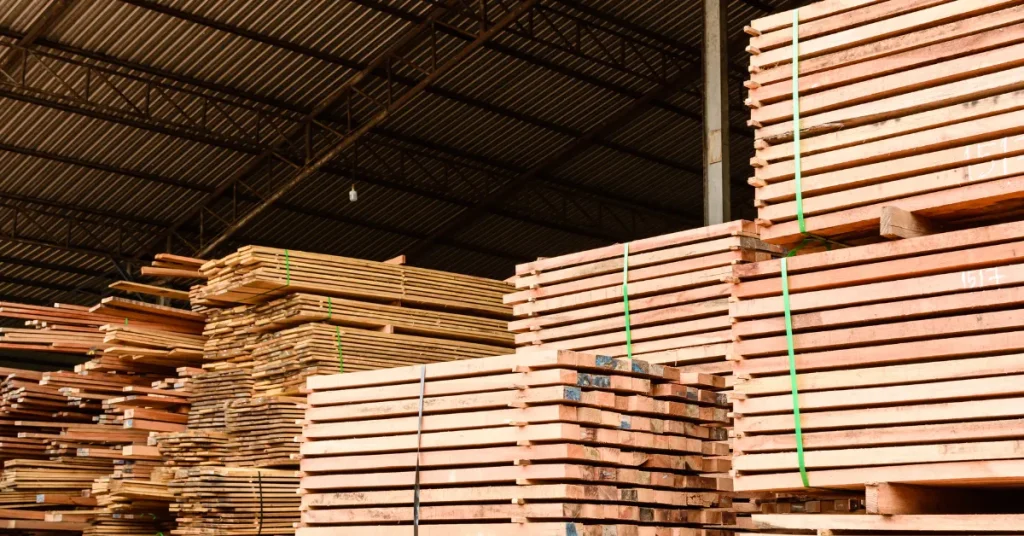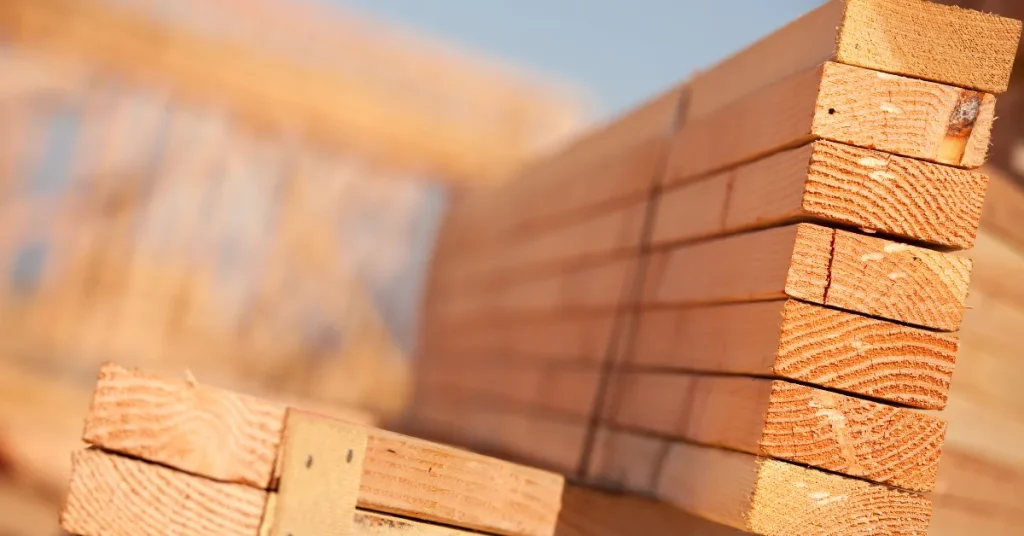A nominal 2×6 board is actually 1.5 inches thick by 5.5 inches wide. This common lumber dimension is critical in construction projects.
In construction and carpentry, the term “2×6” refers to a piece of lumber with nominal dimensions. Despite the name, lumber is typically smaller than its nominal dimensions due to the drying process and planing.
Knowing the actual thickness of a 2×6 is essential for builders and DIY enthusiasts alike, as it affects the structural integrity and fit within a design.
The 1. 5-inch thickness provides a sturdy component in framing, allowing for sufficient support and stability in walls, floors, and ceilings.
Wood’s natural variations make precision in understanding lumber sizes a key factor in successful projects, ensuring that all pieces fit together seamlessly without compromising the strength of the build.

Unpacking Lumber Terminology
Let’s dive into the world of lumber, a key material used in construction and carpentry. Under the subheading ‘Unpacking Lumber Terminology’, we’ll explore the true dimensions of lumber.
This section will help you understand what you’re buying when you pick up a piece of wood marked as ‘2×6’.
Decoding Lumber Measurements
Lumber sizes can be confusing. Lumber dimensions given at stores are not the actual sizes. They are what we call ‘nominal’ sizes. ‘Nominal’ means the size before the lumber is planed and finished. The ‘actual’ size is smaller than the nominal size.
| Nominal Size | Actual Size |
| 2×4 | 1 1/2″ x 3 1/2″ |
| 2×6 | 1 1/2″ x 5 1/2″ |
| 2×8 | 1 1/2″ x 7 1/4″ |
The ‘2×6’ Label: What Does It Really Mean?
The term ‘2×6’ refers to the nominal size of a piece of lumber. But it’s not exactly 2 inches by 6 inches. Here’s a clearer picture of what ‘2×6’ really means:
- The ‘2’ in ‘2×6’ stands for the nominal thickness in inches.
- The ‘6’ is the nominal width in inches.
- Actual size is closer to 1 1/2″ thick and 5 1/2″ wide.
This means a ‘2×6’ is really about 1 1/2″ x 5 1/2″. Always check the label and the actual measurements for the right size for your project.
Actual Versus Nominal Dimensions
Understanding lumber sizes can be tricky. When working on a project, you might grab a 2×6, expecting it to measure exactly two inches by six inches.
Yet the true size can surprise you. This confusion comes from the difference between actual and nominal dimensions.
The Transformation From Rough To Finished Lumber
Lumber starts its life in a rough state directly from the log. It’s then milled down to a smoother, more consistent size for consumer use.
During this process, the wood is planed and trimmed. This transforms it from its rough, irregular shape into a piece with standardized, or ‘nominal’, dimensions.
Let’s explore the steps:
- Sawing: Wood is cut from logs.
- Drying: The wood is dried to reduce moisture.
- Planing: Wood is smoothed out.
- Trimming: Ends are cut for uniformity.
Why Sizes Don’t Match The Names
The ‘2×6’ name is the nominal designation, not the actual size. The real dimensions of a 2×6, once the wood is finished, are notably less. For example, a 2×6 traditionally measures 1.5 inches by 5.5 inches.
Reasons include:
- Shrinkage: Wood loses size as it dries.
- Planing: Surface smoothing reduces dimensions.
Here’s a simple table to help clarify:
| Nominal Size | Actual Size |
| 2×6 | 1.5″ x 5.5″ |
In conclusion, always check actual sizes before you launch into your project. Understanding the true thickness of a 2×6 can save you from headaches and project mishaps.
Measuring 2×6 Lumber
Understanding the dimensions of 2×6 lumber is crucial for any construction project. This commonly used piece of wood helps in building strong frames and structural supports.
Knowing the exact measurements ensures that the construction is both sturdy and meets intended design specifications.
Standard Thickness Of A 2×6
The ‘2×6’ name can be misleading. While the name suggests two by six inches, it’s not the true size.
The actual thickness tends to be less. Before drying and planing, it indeed measures as named. But after processing, the size reduces slightly.
Most often, a 2×6 is actually 1.5 inches thick and 5.5 inches wide. These are its ‘nominal’ dimensions. ‘Actual’ dimensions can be somewhat smaller due to the preparation of the lumber
| Nominal Size | Actual Thickness | Actual Width |
| 2×6 | 1.5 inches | 5.5 inches |
Regional Variations In Lumber Size
Lumber dimensions can differ based on location. Variations are due to regional manufacturing standards and availability of wood types. In North America, the sizes are fairly consistent. But international differences exist.
- In Europe, lumber sizes might differ significantly.
- Measurement systems vary – metric versus imperial.
- Wood species affect the sawing process and dimensions.
Check local codes and standards before purchasing. Matching the lumber to project specs is essential.
Common Uses For 2×6 Lumber

The versatility of 2×6 lumber makes it a go-to choice for various construction and creative projects.
Despite the name “2×6,” the actual measurements are usually 1.5 inches thick by 5.5 inches wide after drying and planing. This size is ideal for many applications.
Structural Applications
Builders favor 2×6 lumber for its strength and reliability in the framework of houses. It is a pivotal material in constructing walls, floors, and roofs.
- Walls: 2x6s give extra space for insulation, keeping homes warm.
- Floors: They provide a sturdy base for flooring materials.
- Roofs: They support the weight of roofing materials and snow.
| Component | Standard Lengths (feet) |
| Studs | 8, 9, 10 |
| Joists | 6 to 16 |
| Beams | Varies by load requirements |
Creative And Alternative Uses
2×6 lumber also inspires DIY enthusiasts to explore beyond traditional building applications. It’s perfect for indoor and outdoor projects.
- Garden beds: 2x6s build raised beds for vegetable gardens.
- Benches: Create sturdy seating for outdoor spaces.
- Shelves: Fashion heavy-duty shelving units for storage.
For those with a creative flair, the lumber can transform into beautiful furniture pieces like tables and bed frames. 2x6s have become a favorite for personalized crafting, from rustic headboards to unique dining tables
Factors Affecting Dimensional Changes
Understanding the true thickness of a 2×6 requires knowledge about factors that alter wood dimensions.
This post explores key influencers like moisture shifts and planning for wood movement in your projects. Keep up as we dive into what makes wood swell or contract.
Moisture Content And Lumber Swelling
Moisture significantly impacts wood size. Here’s why:
- Wood absorbs moisture from air.
- This absorption makes wood expand.
- Dry air causes wood to lose moisture and shrink.
A 2×6’s nominal dimensions are 1.5 inches by 5.5 inches, but these can change. Let’s see how moisture alters these numbers:
| Condition | Thickness | Width |
| High Moisture | >1.5″ | >5.5″ |
| Low Moisture | <1.5″ | <5.5″ |
Planning For Wood Movement In Projects
To avoid issues in your builds:
- Know that wood moves after cutting.
- Leave space for expansion and contraction.
- Choose stable materials for crucial areas.
- Use joints that accommodate movement.
Imagine your project changing with the seasons. It probably will. Build with change in mind.
Remember, the “2×6” label is a starting point. Real size shifts with conditions.
Selecting The Right 2×6

When starting a construction project, selecting the right wood plays a pivotal role. A 2×6 lumber is a common choice for framing and various building needs. The dimensions refer to the lumber’s nominal size, which is different from the actual size.
Before purchasing, understanding the exact measurements and quality of a 2×6 is crucial. Let’s delve into how you can choose the best 2×6 for your project.
Grade And Quality Considerations
The grade of lumber influences both the strength and aesthetic appeal. Look for the grade stamp on each 2×6.
This mark provides information on the wood’s origin, grade, and moisture content. Use this simple checklist:
- Select higher grades for projects where appearance matters.
- Opt for construction-grade lumber for structural purposes.
- Ensure the grade meets the necessary building codes.
Choose lumber marked ‘S-Dry’ or ‘KD’ indicating it has been surfaced-dried or kiln-dried, reducing the chance of warping.
Tips For Assessing Lumber At The Store
- Check each 2×6 for straightness by looking down the length of the board.
- Inspect the wood for any visible defects like knots, splits, or warps.
- Feel the lumber’s surface for smoothness and consistency.
- Avoid pieces with excessive moisture or greenish tints, indicating they are not fully dried.
Laying a strong foundation begins with selecting the best materials. Keep these tips in mind when you’re at the store to ensure your project’s success.
FAQs About How Thick Is A 2×6
How Many Inches Thick Is A 2×6?
A 2×6 lumber board is nominally 2 inches thick. However, its actual thickness is typically 1. 5 inches following standard dimension reduction after drying and planing.
What Is The Actual Thickness Of A 2×4?
The actual thickness of a 2×4 lumber is approximately 1. 5 inches. The width measures about 3. 5 inches. These dimensions are nominal and slightly less than the named sizes.
What Size Is A 2×6 Stud?
A 2×6 stud typically measures 1. 5 inches thick by 5. 5 inches wide, with lengths varying based on construction needs.
How Thick Is A Rough Cut 2×6?
A rough cut 2×6 typically measures about 2 inches in thickness and 6 inches in width, though dimensions can vary slightly.
Conclusion
Understanding the actual thickness of a 2×6 has significant implications for your construction project.
While nominal dimensions suggest 2 inches by 6 inches, the true measurements align closer to 1. 5 by 5. 5 inches. Remember this crucial detail to ensure precise calculations and a successful build.
Always verify local lumber dimensions for the most accurate planning.
Resources:
1. https://basc.pnnl.gov/resource-guides/advanced-framing-insulated-headers
